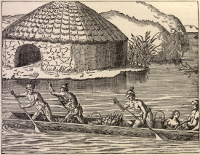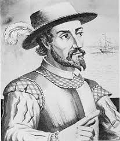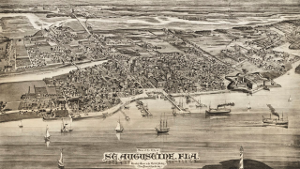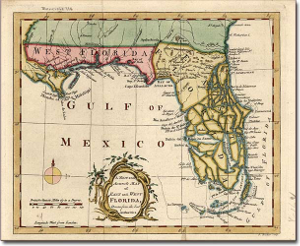The Making of the 50 States: Florida
Part 1: In the Beginning 
Native Americans were living in Florida thousands of years ago. It wasn't until the 16th Century that Europeans arrived. Native American tribes living in what is now Florida at that time included the Apalachee, Calusa, Mayaimi, Timucua, and Tocobaga. Like people in many other areas, they inherited the Woodland and Mississippi cultures. 
Juan Ponce de Leon, the Spanish explorer who famously sought the Fountain of Youth landed in Florida in 1513. His inability to find that fabled landmark didn't dissuade him from coming back. He returned in 1521, with a lot more people, hoping to establish a colony. The Native Americans had other ideas and forcibly convinced the Spanish to leave. De Leon was wounded in the leg during the attack and later died. Ponce de Leon had named the area La Pascua Florida, an English approximation of which is "full of flowers." He was struck with the area's verdant landscape; as well, he had gone ashore at Easter time, and the Spanish festival of Easter was Pascua Florida. 
Spanish explorers kept coming. Panfilo de Narvaez went through in 1528, and Hernando de Soto in 1539 added Florida to his list of future U.S. states that he navigated on a very long troop to the Southwest. It wasn't until 1565 that a Spanish settlement lasted. That was St. Augustine, established by Pedro Menendez de Aviles. A year earlier, French settlers had built Fort Caroline, near what is today Jacksonville. The French and Spanish would contest Florida for a number of years; Fort Caroline would not last. English settlers and explorers had generally avoided Florida until 1586, when Sir Francis Drake ravaged the countryside and devastated the settlement of St. Augustine, as part of an overall policy of harassing Spanish ships and settlements, part of a number of antagonistic acts that convinced Spain's King Philip II to launch the Spanish Armada in 1588. 
Spain took control of Florida and ruled it until 1763, when, as a consequence of the losing the Seven Years War to Great Britain, they handed over Florida to the British. Britain divided the territory into East Florida and West Florida. British efforts to control the area accelerated, as settlers came from Georgia, South Carolina, and further north. One large group came from the Bermuda colony. British industriousness produced fruit, indigo, and sugar cane crops and roads to facilitate transport. An experimental settlement by Scottish settler Dr. Andrew Turnbull transplanted about 1,500 people from European environs to the colony of New Smyrna; the settlement did not last. Many people who lived in Florida had no sympathy for the northern colonies who declared themselves independent from Great Britain in 1776. Florida sent no delegates to the Continental Congresses. Both East Florida and West Florida remained loyal to Great Britain during the Revolutionary War. In fact, Floridians helped British soldiers conduct raids into Georgia. American forces invaded Florida twice and were soundly defeated both times. Spain took the opportunity to capture Pensacola in 1781. The end of the Revolutionary War brought Florida back into the Spanish fold; Spain and the United States agreed on the boundaries in a 1795 treaty. Next page > The Rest of the Story > Page 1, 2
|
|
Social Studies for Kids
copyright 2002–2024
David White




